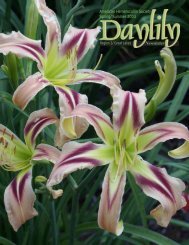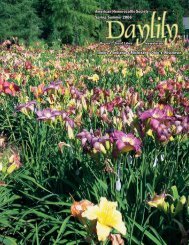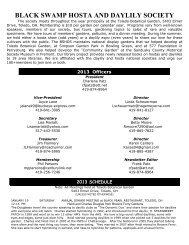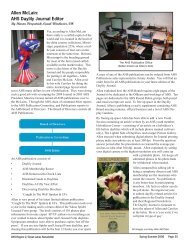Pages - AHS Region 2
Pages - AHS Region 2
Pages - AHS Region 2
You also want an ePaper? Increase the reach of your titles
YUMPU automatically turns print PDFs into web optimized ePapers that Google loves.
<strong>AHS</strong> <strong>Region</strong> 2/Great Lakes Newsletter<br />
Richard Ford and Betty Thomsen<br />
tain things. We judge the scapes against their registered<br />
standards. The game really begins when the<br />
people exhibiting suddenly realize what they have to<br />
do. Suddenly some people start winning all the awards,<br />
and the others get mad at them. They have figured out<br />
how to play the game; they have learned what a winning<br />
scape is.<br />
Gus: Do you ou often en get t ungroomed scapes from om people<br />
who simply don’t know w what is a showable scape<br />
Richard:<br />
Oh, yes. I once had a person exhibit a scape<br />
without any open flower on it, only buds. You could<br />
see that these buds would open the next day. The other<br />
exhibition judges and I could only smile. It was such a<br />
contorted idea of what to exhibit.<br />
Some people don’t realize that you have to clean the<br />
scape before exhibiting it. The idea is that you need to<br />
exhibit something as perfect as you possibly make it<br />
for the public showing. You are doing this for the public.<br />
As judges we come along and say “this is really<br />
done well by the exhibitor.”<br />
GREEN FLUTTER is one cultivar that you can bring<br />
right from the garden, and it will be perfect. If you can<br />
pick it when it first starts blooming, you don’t need to<br />
do anything to its scape. I won Best of Show with one.<br />
I had looked in The Daylily Journal to see which plants<br />
won most often, and that was my pick.<br />
Gus: Actually<br />
ctually, , an exhibition judge once asked me in a<br />
garden if a cultivar was correct. GRAPE VELVET VET had white<br />
edges on its petals. She had never er seen it blooming that<br />
way. . I told her it was a result of lack of wat<br />
ater<br />
er. . That is why<br />
I have difficulty iculty with the wording “true to cultivar<br />
ar.”<br />
Richard:<br />
That is also why exhibition judges have to get<br />
out just as much as garden judges. They must constantly<br />
see everything. What is a certain cultivar going<br />
to look like when it has been dry and hot during<br />
Page 12 Fall 2000/Winter 2001<br />
An Inter<br />
ervie<br />
view with Richard Ford<br />
ord<br />
ord (continued from page 9)<br />
the growing season What is it going to look like at<br />
the end of its bloom season There are some shows<br />
when the date ends up much later in the bloom season<br />
than expected. Exhibition judges have to take into consideration<br />
that the summer was hot and dry, and that<br />
most flowers are going to be at the end of their bloom<br />
cycle. When judging, you have to be aware of such<br />
things and take all that information into consideration.<br />
Gus: The point system would still give them credit<br />
Richard:<br />
You have to know to back off and take all criteria<br />
into consideration. You have to take everything that<br />
has come from outside in the gardens into consideration.<br />
That just takes a lot of experience of looking at things<br />
and watching what happens in gardens and then coming<br />
to the display table and saying, “Well, this is what<br />
will affect daylilies.” The color might be slightly off. Yet,<br />
you may be surprised that someone will bring in a exhibition<br />
scape that is perfect because this has to do with<br />
garden culture as well. If exhibitors grow them well in<br />
the garden, they will look good on the display table.<br />
Gus: What about those “miniatures” that keep blooming<br />
at three and a half inches<br />
Richard:<br />
This has always been a problem and always<br />
will be. Suppose something is registered as 3.5 inches,<br />
and it comes in at 4 inches and is displayed as a miniature.<br />
The only thing an exhibition judge can go by is<br />
what the hybridizer has said in the cultivar’s registration.<br />
You, as exhibition judge, have to assume that the<br />
hybridizers grew the cultivars as best as they could in<br />
the garden, and that the hybridizers know what the<br />
plants can do. When the cultivar gets into commerce,<br />
it should be pretty much the same bloom size in every<br />
location. As an exhibition judge, you should know how<br />
plants do in your region. Most times you judge in your<br />
region, and you know if it is going to vary or not. It<br />
gets really difficult when you judge a show in another<br />
region; plants sometimes grow differently down South<br />
than they do here. Colors are different; sizes are different;<br />
branching is different.<br />
Gus: If a flo<br />
lower is registered ered as 2-1/2 inches but always<br />
grows 3-1/2 inches, and you see it displayed that size as<br />
a miniature–which h it must be–does it still get t full points<br />
Richard:<br />
No. You really can’t give it the full amount of<br />
points. You have to go back to what its registration<br />
says and what the public is going to see. If you are<br />
going to give a purple ribbon to something that is big<br />
but that is exhibited in the miniature class, the public<br />
is going to get the wrong idea. It sometimes might not<br />
seem fair, but it is also up to the exhibitor to be knowledgeable<br />
as to what is appropriate to show.<br />
Gus: If someone brought in an 8-inch BARBARA<br />
MITCHELL, it would lose points<br />
Richard:<br />
Yes, that is correct. An 8-inch BARBARA














